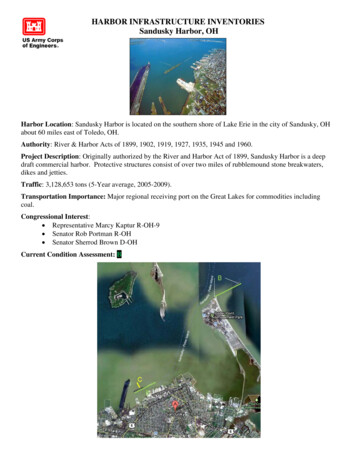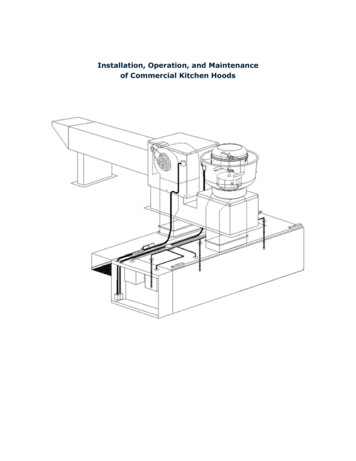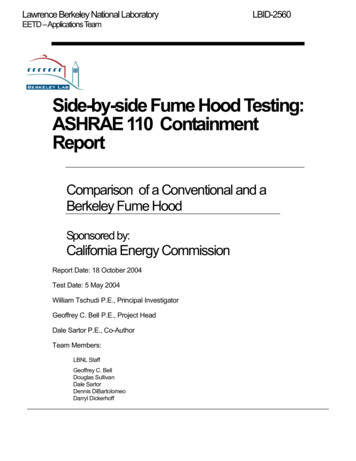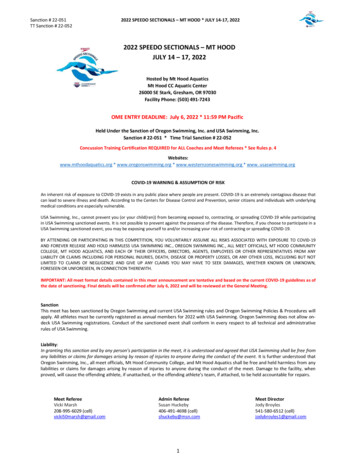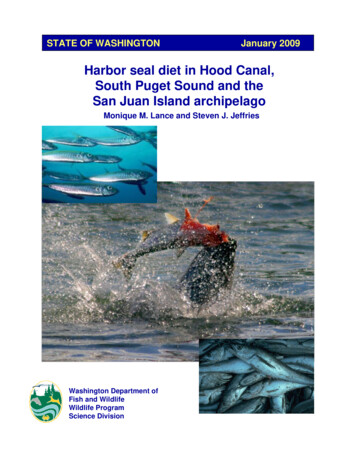
Transcription
STATE OF WASHINGTONJanuary 2009Harbor seal diet in Hood Canal,South Puget Sound and theSan Juan Island archipelagoMonique M. Lance and Steven J. JeffriesWashington Department ofFish and WildlifeWildlife ProgramScience Division
Suggested Citation:Lance, M.M., and S.J. Jeffries. 2009. Harbor seal diet in Hood Canal, South Puget Sound and theSan Juan Island archipelago. Contract Report to Pacific States Marine Fisheries Commission forJob Code 497; NOAA Award No. NA05NMF4391151. Washington Department of Fish andWildlife, Olympia WA. 30 pp.Cover photos: Josh London, NOAA (center), Alaska Fisheries Science Center, ResourceAssessment and Conservation Engineering (insets)
Harbor seal diet in Hood Canal, South Puget Sound and the San Juan Island ArchipelagoFinal ReportStudies of Expanding Pinniped PopulationsPacific States Marine Fisheries Commission26 January 2009Monique M. Lance and Steven J. JeffriesWashington Department of Fish and WildlifeWildlife Science Program7801 Phillips Road SWLakewood, Washington 98498Period: 1 July 2008 through 31 December 2008PSMFC Job Code 497NOAA Award No. NA05NMF4391151
iAcknowledgementsThe National Marine Fisheries Service (NMFS) through the Pacific States Marine FisheriesCommission (PSMFC) funded the Hood Canal portion of this project. Additional funding andsupport for this project were provided by the Washington Department of Fish and Wildlife. Wethank key field and laboratory personnel: Josh London, Dyanna Lambourn, Bryan Murphie, TomCyra, Joe Evenson, Jeff Gould, Belen Roca, Kelly Brock, Tammy Schmidt, Marissa Stratton,Aaron Galloway, Shannon Murphie, and Amelia Brower. Access to collection sites and logisticsupport was provided by: Gary Phillips at Quilcene Bay; Steve Middleton and Doug Hinton atDosewallips State Park; and WDFW Region 6 for the Duckabush River access area. Dr. GlennVanBlaricom and the WACFWRU provided support for field and laboratory analysis.WDFW state marine mammal funding and NMFS through PSMFC funded the south PugetSound portion of this project. We thank Harriet Huber (NOAA, National Marine MammalLaboratory) for support of Gertrude Island harbor seal research efforts, Dyanna Lambourn forsample collection and Aaron Galloway and Amelia Brower for sample processing.The SeaDoc Society Research Agreement K004431-25 and NMFS through PSMFC funded theSan Juan Island portion of this project. We thank key field and laboratory personnel: Jeff Gouldfor assisting with boat operations and field collection of samples; Amelia Brower, AaronGalloway, Katie Luxa and Melissa Erkel for assistance with field collection and sampleprocessing; Kevin Ryan and Ulrich Wilson (USFWS) permitted access to intertidal areas at siteswithin the San Juan Islands Wildlife Refuge; and Phil Green (The Nature Conservancy)permitted access to intertidal areas of Goose Island for sample collection.We thank Susan Riemer (ODFW) and William Walker (NOAA, National Marine MammalLaboratory) for assistance with prey identification on difficult samples; Scott Pearson (WDFW)for reviewing this report and providing valuable input; and Harriet Huber and Jim Thomason(NOAA, National Marine Mammal Laboratory) for use of the National Marine MammalLaboratory food habits lab for scat sample processing. Thank you Wayne Palsson (WDFW) forproviding recent trawl data; Dan Penttila (WDFW) for providing forage fish information; KyleAdicks (WDFW) for providing regional salmon abundance data; and Jeff Foisy (WDFW) forcreating Figs 1-4. Harbor seal research activities were conducted under MMPA Research Permit782-1702-00.i
iiAbstractHarbor seals are the most abundant resident pinniped species in Puget Sound. They forage highon the food chain, are a relatively long-lived species, and have been used as sentinels of marineecosystem health. Harbor seals are primarily piscivorous and consume seasonally and locallyabundant prey, which allows us to investigate changes in their prey base, both on a temporal andspatial basis by examining diet. We use percent frequency of occurrence of prey species in fecalsamples (scats) collected from river mouths in Hood Canal, sandy haulouts in South Puget Soundand rocky island and reef haul outs in the San Juan Islands to describe diet seasonally andregionally and to examine potential changes in diet over time.In Hood Canal during fall (1998-2001 and 2003-2005), harbor seals fed mainly on Pacific hake(occurring in 79% of samples), Pacific herring (30%) and adult salmonids (26%). Diet shiftedduring spring (1999 and 2005) with Pacific hake (85%) and Pacific herring (26%) remainingimportant, but Northern anchovy (35%) increasing significantly and adult salmonids (8%)decreasing significantly.South Puget Sound diet was dominated by gadids (99%), both Pacific tomcod and Pacific hake.Clupeid species (69%) also composed a large proportion of the diet, but unlike the other regions,plainfin midshipman (47%) and flat fish (33%) were primarily primary prey for harbor seals.Minor seasonal fluctuations in occurrence were observed for cephalopods, shiner surfperch,juvenile salmonids and rockfish. Prey assemblages in south Puget Sound seal diet are likely dueto differences in habitat and the predominance of relatively shallow and calm inlets and bays.In the San Juan Islands, Pacific herring was the most important prey species overall (57%).Gadid species (winter and spring), adult salmon (summer/fall), Pacific sand lance (winter andspring), and Northern anchovy (winter) were important more seasonally. The San Juan Islandsare influenced by the Strait of Juan de Fuca and Strait of Georgia and seal diet reflects thisdynamic region.In comparing these three very different regions, clupeids (primarily herring) were a significantcomponent of seal diet in each region. Adult salmonids are important seasonally in Hood Canaland the San Juan Islands and a gadid species and Pacific herring dominate the diet year round.As adult salmon migrate into the region and become abundant, harbor seals forage primarily onsalmon (range 25–67% frequency of occurrence). For gadids, seals preyed primarily on Pacifichake in Hood Canal, Pacific tomcod and Pacific hake in south Puget Sound, and walleye pollockin North Puget Sound/San Juan Islands. Northern anchovy were important in Hood Canal and theSan Juan Islands during winter, but not in South Puget Sound. High proportions of midshipmanand flat fish in seal diet were unique to South Puget Sound. Many of the other important preyspecies were similar among regions including shiner surfperch, cephalopods, sand lance andsculpins. These data correlate well with species composition in each region and suggest thatharbor seal diet provides a good indicator of fish availability and can be used to detect localizedchanges in prey availability.ii
iTable of ContentsAcknowledgements . iAbstract. iiIntroduction. 1Methods. 2Results . 3Discussion. 6Literature Cited . 10i
iiList of FiguresFigure 1. Study area showing Hood Canal, south Puget Sound and San Juan Islands,Washington. 14Figure 2. Map of Puget Sound and Hood Canal showing sample collection locations. 15Figure 3. Map of south Puget Sound showing sample collection locations. 16Figure 4. Map of the San Juan Islands showing sample collection locations . 17Figure 5. Overall weighted average of primary ( 10%) prey species in the diet of harborseals for all seasons and years combined in Hood Canal, south Puget Sound and the SanJuan Islands. 18ii
iiiList of TablesTable 1. Number of harbor seals scats collected (“C”) and with remains (“R”) by haul outsite during fall (July – early December) 1998, 1999, 2000, 2001, 2003, 2004 and 2005 byyear in Hood Canal, Washington. . 19Table 2. Number of harbor seals scats collected (“C”) and with remains (“R”) by haul outsite during spring (March-June) 1999 and 2005 in Hood Canal, Washington. . 19Table 3. Number of harbor seals scats collected (“C”) and with remains (“R”) by haul outsite by season in 1995, 1997, 2004 in south Puget Sound, Washington. . 20Table 4. Number of harbor seal scats collected by season and region in the San JuanIslands 2005-2007. Collection location details found in Lance and Jeffries 2007. . 20Table 5. Percent frequency of occurrence (FO) of prey species identified using allstructures (bone and otoliths) in harbor seal scats during fall (July – early December) of1998, 1999, 2000, 2001, 2003 and 2004 by year in Hood Canal, Washington. 21Table 6. An annual comparison of the percent frequency of occurrence (FO) of primaryprey species identified using all structures (bone and otoliths) in harbor seal scats by riversystem in Hood Canal, Washington during fall (late July – early December) of 1998, 1999,2000, 2001, 2003 and 2004. . 23Table 7. Percent frequency of occurrence (FO) of prey species identified using allstructures (bone and otoliths) in harbor seal scats during spring (March-June) 1999 and2005 in Hood Canal, Washington. . 25Table 8. Percent frequency of occurrence (FO) of prey species identified using allstructures (bone and otoliths) in harbor seal scats during fall 1995, spring 1997, summer1997, winter 1997 and fall 2004 in south Puget Sound, Washington. . 26Table 9. Frequency of occurrence (FO; expressed as percent) and overall weighted averageof prey species in the diet of harbor seals by season in the San Juan Islands, 2005-06. 28Table 10. Frequency of occurrence (FO; expressed as percent) and overall weightedaverage of prey species in the diet of harbor seals by season in the San Juan Islands, 200607. 30iii
1IntroductionIncreases in pinniped populations have coincided with dramatic decreases in many marine andanadromous fish populations (WDF et al. 1993, Bargmann 1998, Jeffries et al. 2003). Gadids(cod species) and forage fish in general, and herring specifically, are vital components of themarine food web and are an important indicator of the overall health of the marine environment.Pacific herring form the base of the Puget Sound marine food web, supporting higher trophicfish, seabirds, and marine mammals (Calambokidis et al.1978, Calambokidis et al.1989, Olesiuket al. 1990, Suryan and Harvey 1998, Lance and Thompson 2005, Stick 2005, Lance and Jeffries2006, Lance and Jeffries 2007). The role of seal and sea lion predation in structuring marineecosystems and affecting recovery of depressed fish stocks is a critical management issue(NMFS 1997). The collapse of fisheries throughout the Pacific Northwest has fueled the need tomove away from a single-species management approach and beyond conventional methods ofmarine coastal management (Bargmann 1998). Healthy and sustaining populations of nativespecies in Puget Sound, including a robust food web is one of the Puget Sound Partnership’secosystem recovery goals (Puget Sound Partnership 2008)The harbor seal is the most abundant resident pinniped species in the inland waters ofWashington. In Hood Canal they use five primary haulouts located at the major river mouths aswell as on oyster rafts in Quilcene Bay and number over 1,000 animals (Jeffries et al. 2003). Insouth Puget Sound they use five primary haulouts located on reefs, islands, private floats, and logbooms, and number approximately 1,200 animals (Jeffries et al. 2003). In the San Juan Islandsthey use over 150 intertidal haulout locations and number nearly 4,000 animals (Jeffries et al.2003). There are an additional 1,000 animals in the adjacent Gulf Islands in British Columbia tothe west and 2,000 animals in the Eastern bays (Samish, Skagit, Padilla and Bellingham Bays) tothe east (Jeffries et al. 2003). Harbor seals in the San Juan Islands, Hood Canal and Strait ofGeorgia forage within approximately 10 kilometers of a haulout site with most individualsforaging in the same specific area and returning to the same haul out site (Suryan and Harvey1998, Olesiuk 1999, WDFW unpub. data). Because harbor seals forage in close proximity tohaulout sites and eat locally abundant fish species, research on their diet can be used to examinetemporal and spatial variability in their prey base, how the prey base varies over time and space,and their role in shaping the complex marine ecosystem.In Washington, harbor seal diet data is generally composed of small schooling forage (primarilyherring) and various groundfish species. The status of Puget Sound herring stocks varies byregion. South and central Puget Sound herring stocks have maintained a healthy populationstatus since first evaluated in 1994, however north Puget Sound region herring stocks havemoved progressively to depressed in recent years in large part due to the decrease in spawningbiomass for the Cherry Point stock. The Strait of Juan de Fuca region stock status has beenconsistently classified as critical since 1994, primarily due to the condition of the Discovery Baystock, which has remained at a very low level of abundance (Stick 2005). For groundfish, theGeorgia Basin Pacific hake stock at one time comprised the largest fishery in central and northPuget Sound, but spawning biomass has declined 85% over the past 15 years and the fishery isnow closed (Gustafson et al. 2000). Central Puget Sound Pacific hake are candidates for listingby Washington State (Brown and Gaydos 2005). Populations of Pacific cod in North PugetSound are “depressed” with south and central Puget Sound populations of this fish listed as1
2candidates species for listing by Washington State (Brown and Gaydos 2005). Simultaneously,pinniped populations have increased seven to ten-fold in Washington with passage of the MarineMammal Protection Act in 1972 (Jeffries et al. 2003). Harbor seals are unquestionably affectedby the dramatic shifts that have occurred in their prey base. Understanding the importance ofthese prey species in the diet of harbor seals is needed to help develop ecosystem-based recoveryand management strategies for Puget Sound, Hood Canal and the Strait of Georgia.Harbor seals are known to consume a wide range of prey sizes including adult salmonidsreturning to rivers to spawn, out-migrating salmon smolts, gadids, flatfishes, and small schoolingforage fishes (Calambokidis et al.1978, Calambokidis et al.1989, Olesiuk et al. 1990, Riemer etal. 1999, London et al. 2001, Browne et al. 2002, Orr et al. 2004, Lance and Jeffries 2006, Lanceand Jeffries 2007). Seasonal abundance of prey species undoubtedly plays a key role in theforaging ecology and diet of harbor seals. Determining harbor seal diet in Puget Sound, bothspatially and temporally, has important implications for fisheries biologists in understandingwhether harbor seal populations are consuming young of the year fishes that would be recruitedinto the population (e.g. Pacific herring), or larger fish with greater reproductive output (e.g.adult salmon) and consequently has significant population effects on the prey base. Harbor sealdiet comparisons are also useful in addressing the question of multispecies and communityeffects by examining changes in fish size and composition over time.In this study, we present harbor seal diet data from three distinct regions in Puget Sound: HoodCanal, south Puget Sound and San Juan Island archipelago. This report collates these data toallow for comparison among years, between seasons and among regions. Different project goalsand study designs were employed in each region. Hood Canal diet data were collected as part ofthe west coast pinniped predation study focused on threatened and endangered salmonconsumption by pinnipeds (London et al. 2001). South Puget Sound diet data were collectedopportunistically during captures and observations at WDFW long term monitoring locations atGertrude Island and Eagle Island (Lambourn et al. 2008). San Juan Island diet data werecollected to examine the dependence of harbor seals on forage fish and rockfish communities, tostrive to understand how they integrate into and impact the marine food web and to investigatethe role of harbor seals in Marine Protected Areas designed to recover fish stocks (Lance andJeffries 2006, Lance and Jeffries 2007). We obtained a large sample size of fecal samples (scats)and used these to examine all prey species in harbor seal diet. Our study assumes that harbor sealdiet composition reflects the composition and abundance of local prey species. We believe thisassumption is reasonable because, harbor seals have been shown to eat what is seasonally andlocally abundant (Olesiuk et al. 1990, London et al. 2001, Browne et al. 2002, Orr et al. 2004,Lance and Jeffries 2006, Lance and Jeffries 2007), they use haul out sites within 10 km offoraging areas and return to those haul out sites at regular intervals and deposit scat (Suryan andHarvey 1998, Olesiuk 1999, WDFW unpub. data) and hard parts (bones, otoliths, squid beaks)found in scats are representative of species being consumed by seals (Harvey 1989, Cottrell etal.1996, Bowen 2000, Orr and Harvey 2001)MethodsSample collection. In Hood Canal, scat collections were attempted at roughly 10-14 dayintervals during fall and spring. Fall collections were made from mid July to early December at2
3harbor seal haulout areas near Quilcene Bay (1998-2001, 2003, 2005), Dosewallips River (19982001 and 2003-2005), Duckabush River (1998-2001, 2003, 2005), Hamma Hamma River (19982000 and 2005) and the Skokomish River in 1998-1999 and 2004- 2005) (Table 1, Figure 2).Spring collections were made from March to June at harbor seal haulout areas near QuilceneBay, Dosewallips River and Skokomish River (1999 and 2005) and Duckabush River andHamma Hamma River (2005) (Table 2, Figure 2).In south Puget Sound, scats were collected opportunistically during captures and observations atGertrude Island during fall 1995, spring 1997, summer 1997, winter 1997 and fall 2004 and atEagle Island during spring 1997, summer 1997 and winter 1997 (Table 3, Figure 3).In the San Juan Islands, scats were collected seasonally over three “collection windows”delineated as: 1 March-30 April (‘spring’), 1 August–30 September (‘summer/fall’) and 1December–30 January (‘winter’) 2005-2007 (Table 4, Figure 4). Scats were collected on rockyhaulout locations during daytime low tide windows from six regions in the San Juan Islandsdesignated as: ‘South Strait of Georgia’, ‘North Rosario Strait’, ‘Eastern Bays’, ‘South RosarioStrait’, ‘South San Juan Channel’, and ‘North San Juan Channel’ (Figure 4). Two to threecollection trips were made each season and 100 scats was the target sample size for each region(Trites and Joy 2005). Effort was adjusted to allow for meaningful statistical analyses. Hauloutlocations on rocks or islands with important seabird colonies precluded collections during criticalseabird nesting and breeding periods at some sites from 15 April – 31 August. Samples werecollected in either plastic ‘Whirlpak’ bags or in fine mesh paint strainer bags and frozen untilprocessing.Sample processing. Samples were cleaned using a washing machine (Orr et al. 2003) or usingnest sieves if samples contained rocks that would damage prey remains in the washing machine(Lance et al. 2001). Prey were identified to the lowest possible taxon using a dissectingmicroscope, reference fish bone collections from Washington and Oregon, and published bone,otolith and cephalopod beak keys (Kashiwada et al. 1979, Morrow 1979, Wolff 1982, Clarke1986, Cannon 1987, Harvey et al. 2000, Lance et al. 2001). Data were entered into an Accessdatabase.Data analyses. Diet data are presented as percent frequency of occurrence. To account fordifferences in samples sizes among seasons, we present an unweighted average that wascalculated by taking the mean percent frequency of occurrence of the three seasons for eachspecies. Samples did not contain bones identified to both the species level (e.g. walleye pollock)and family level (gadid species) unless they were different size (age) classes (e.g. large walleyepollock bones and otoliths and few small gadid species bones). Scientific fish names are fromHart 1973.ResultsHood Canal.In Hood Canal, a total of 2,578 scats were collected during fall (Fig 3, Table 1) and 314 scatswere collected during spring (Fig 3, Table 2). Data analyses were based on 98% and 99% ofharbor seal scats that contained identifiable prey during fall and spring, respectively. Marine and3
4anadromous fishes were found in all samples analyzed and cephalopods occurred in 7-12% ofsamples.Overall, harbor seals in Hood Canal fed primarily on Pacific hake (63% occurrence, hereafterhake), clupeids (primarily Pacific herring, 49%, hereafter herring), and adult salmonid species(26%) during fall (Table 2). Frequency of occurrence of hake, herring and adult salmonidsfluctuated slightly from year to year, however; their importance in the diet remained relativelyconstant. The adult “salmonid species” category may include any species of salmonid, hatcheryor wild, that might be in the San Juan Islands during the study period, but which cannot beassigned to species from scats because the bones recovered are not species specific. Two otherimportant species that occurred in greater than five percent of samples were, shiner surfperch(9%) and cephalopods (octopus and squids) (6%). Overall, fall diet was reasonably consistentamong river systems with hake, herring and salmon dominating each year and shiner surfperchand cephalopods present in smaller proportions (Table 3). One small difference was the presenceof threespine stickleback in Quilcene Bay, particularly during fall 2000. During spring 1999 and2005, hake remained the most common prey species consumed, however; herring decreased inimportance and shiner surfperch and northern anchovy increased (Table 7).South Puget Sound.In south Puget Sound, a total of 314 scats were collected during fall (Figure 3, Table 3). Dataanalyses were based on 98% of harbor seal scats that contained identifiable prey. Marine andanadromous fishes were found in all samples analyzed and cephalopods occurred in 19% ofsamples.Overall, almost all samples (99%) collected at Gertrude Island and Eagle Island in south PugetSound contained gadids (primarily Pacific tomcod and Pacific hake, 43% and 34% respectively)(Table 8). Three other primary prey species included clupeid species (69%), plainfin midshipman(47%), and flat fish (33%) that were primarily starry flounder and English sole. The “clupeidspecies” category could include any species of clupeid including Pacific herring, American shad,and Pacific sardine, but which cannot be assigned to species because the bones recovered are notspecies specific (e.g. vertebrae). Similarly, the “gadid species” category could include thosespecies of gadid found in Puget Sound including Walleye pollock, Pacific tomcod, Pacific hakeand Pacific cod, but which cannot be assigned species because bones recovered were not speciesspecific. Other important species that occurred in greater than five percent of samples were, indecreasing order of importance, cephalopods (19%), shiner surfperch (14%), juvenile salmonids(13%), and rockfish species (9%) (Table 8). There were not large seasonal differences in dietobserved. Gadids, clupeids, midshipman, and flatfish were relatively consistent in the diet yearround. The following minor fluctuations in occurrence were observed: cephalopods were mostcommon during fall and spring; shiner surfperch were most common during spring; juvenilesalmonids were more common during spring and summer; and rockfish were most commonduring summer (Table 8).San Juan Islands.During three collection periods (‘spring’, ‘summer/fall’ and ‘winter’), a total of 899 scats werecollected from sites distributed throughout the San Juan Islands during both years (Figure 4,Tables 9 and 10). Data analyses were based on 99% (507 of 509 collected) and 98% (392 of 3984
5collected) of harbor seal scats that contained identifiable prey during 2005-2006 and 2006-2007,respectively. Marine and anadromous fishes were found in all samples analyzed and cephalopodsoccurred in 7-11% of samples.Overall, in 2005-2006 harbor seals fed primarily on Pacific herring (57% occurrence), adultSalmonid species (26%), Gadid species (24%), and Pacific sand lance (20%) in the San JuanIslands (Table 9). Other important species that occurred in greater than five percent of sampleswere, in decreasing order of importance, Northern anchovy, Walleye pollock, Spiny dogfish,sculpin species, flatfish species, cephalopods and skate species (Table 9).Seasonal changes in diet composition were observed during 2005-2006 in the San Juan Islands.Clupeid species, primarily Pacific herring, were important prey for San Juan Islands harbor sealsyear round. Gadid species were important prey species in the San Juan Islands primarily duringwinter and spring. Walleye pollock occurred in over 40% of harbor seal samples collected duringspring and was also present in samples collected during both summer/fall and winter collectionperiods (Table 9). Summer/fall diet was dominated by returning adult salmonid species. Clupeidswere found in over 65% of samples collected during the winter, but harbor seal diet also becamemore varied with Northern anchovy, Gadid species, Pacific sand lance, Spiny dogfish, skates,cottid species, flatfish species, snailfish species and cephalopods all found in greater than 13% ofsamples collected (Table 9).Overall, in 2006-2007 harbor seals fed primarily on Pacific herring (57% occurrence), adultsalmonid species (19%), and walleye pollock (15%) in the San Juan Islands (Table 10). Otherimportant species that occurred in greater than five percent of samples were, in decreasing orderof importance, rockfish species (12%), threespine stickleback (12%), cephalopods (octopus andsquids) (11%), shiner perch (11%), Pacific sand lance (10%), gadid species (9%), clupeid species(9%), Northern anchovy (8%), skate species (6%), sculpin species (6%), and eelpout species(5%) (Table 1).Seasonal changes in diet composition were observed during 2006-2007 in the San Juan Islands.Clupeid species, primarily Pacific herring, were important prey for San Juan Islands harbor sealsyear round, but primarily during spring (91%) and winter (71%). Adult salmonid species werethe dominant prey species during the summer/fall collection period. Gadid species wereimportant prey species in the San Juan Islands primarily during winter. Walleye pollock was themost important of the gadid species present in their diet and occurred in 21% and 16% of harborseal samples collected during winter and summer/fall and was also present in samples collectedduring the spring collection period (Table 10). Northern anchovy was an important prey speciesin seal diet almost exclusively during spring (Table 10). Diet became more varied during thewinter, with clupeids still dominant (71% of samples collected), but gadids (specifically walleyepollock), sculpins, shiner perch, rockfish and cephalopods (squid and octopus) were found ingreater than 15% of samples collected (Table 10).Regional comparison.In all three regions, clupeids (primarily herring) were important in harbor seal diet year round(Figure 5, Tables 5-10). In each region, gadids dominated the diet however the gadid specieslargely differed by region. In general, Hood Canal seals ate hake during fall and spring, in South5
6Puget Sound seals ate tomcod and also hake and in the San Juan Islands harbor seals ate walleyepollock. Adult salmon were important seasonally in Hood Canal and the San Juan Islands duringsummer/fall, but not in south Puget Sound. Similarly, northern anchovy were importantseasonally in Hood Canal and the San Juan Islands during winter, but not in south Puget Sound.High proportions of midshipman and flat fish (primarily starry founder and english sole) in sealdiet were unique to south Puget Sound. Many of the other important prey species were similaramong regions including shiner surfperch, cephalopods, sand lance and sculpins (Figure 5).DiscussionHood Canal.Food habits data indicate that Hood Canal harbor seals are opportunistic predators feeding on avariety of prey species, primarily schooling fishes, adult salmonids, and cephalopods. Hake,herring, adult salmon, shiner surfperc
Monique M. Lance and Steven J. Jeffries. Suggested Citation: Lance, M.M., and S.J. Jeffries. 2009. Harbor seal diet in Hood Canal, South Puget Sound and the . Dosewallips State Park; and WDFW Region 6 for the Duckabush River access area. Dr. Glenn . Kevin Ryan and Ulrich Wilson (USFWS) permitted access to intertidal areas at sites .

